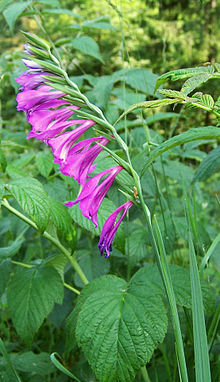
Gladiolus is a genus of perennial cormous flowering plants in the iris family (Iridaceae).

Rejvíz is the highest Silesian village in the Czech Republic, and an administrative part of Zlaté Hory. It is also the most important tourist area in the northern part of the Protected Landscape Territory of Jeseník.

Gladiolus dalenii is a species of flowering plant in the iris family Iridaceae. It is one of the most widely distributed species of Gladiolus, ranging from eastern South Africa and Madagascar throughout tropical Africa and into western Arabia. It is the main parental species of the large flowering grandiflora hybrids. This species is also unusual in its genus in including diploid, tetraploid and hexaploid races. The hybrids produced from it are often tetraploids.

Gladiolus murielae is a species of flowering plant in the family Iridaceae, native to eastern Africa, from Ethiopia to Malawi. It has been given a number of English names, including Abyssinian gladiolus and fragrant gladiolus. It was formerly placed in the genus Acidanthera.
Bean yellow mosaic virus is a plant pathogenic virus in the genus Potyvirus and the virus family Potyviridae. Like other members of the Potyvirus genus, it is a monopartite strand of positive-sense, single-stranded RNA surrounded by a capsid made for a single viral encoded protein. The virus is a filamentous particle that measures about 750 nm in length. This virus is transmitted by species of aphids and by mechanical inoculation.

Orthocarpus, or owl's-clover, is a genus of flowering plants in the family Orobanchaceae. They are native to North America. A number of species formerly included in Orthocarpus have been transferred to the genus Castilleja, which includes the plants commonly known as Indian paintbrush. Plants of the genus are generally less than 30 centimetres (1 ft) in height.

Gladiolus italicus is a species of gladiolus known by the common names Italian gladiolus, field gladiolus, and common sword-lily.

Crocoideae is one of the major subfamilies in the family Iridaceae.
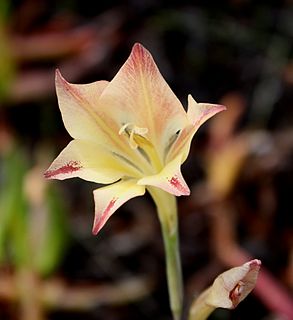
Gladiolus tristis is a species of gladiolus known by several common names, including ever-flowering gladiolus and marsh Afrikaner. It is native to southern Africa, especially South Africa. It is known in parts of Australia and coastal California as an introduced species. It is sometimes grown as a garden plant. This gladiolus typically grows one half to one metre in height, but has been known to approach 1.5 metres tall. It grows from a corm one or two centimetres wide. It produces three narrow, sheathing leaves. The inflorescence is a spike of two to eight large, fragrant blooms. Each flower has six white or cream tepals with greenish or purplish midlines. The flowers are said to have a scent similar to carnations and cloves. Not all individuals possess scent because the allele for its presence is recessive in relation to the allele for its absence.

Gladiolus palustris, common name marsh gladiolus or sword lily, is a herbaceous perennial plant belonging to the genus Gladiolus of the family Iridaceae. The genus name Gladiolus is the Latin diminutive of gladius, a sword, while the specific Latin name palustris, meaning growing in marshes, refers to the alleged environment of this species.
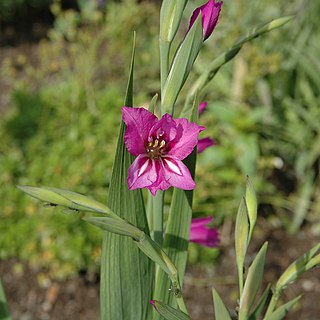
Luitemaa Nature Reserve is a nature reserve situated in south-western Estonia, in Pärnu County.
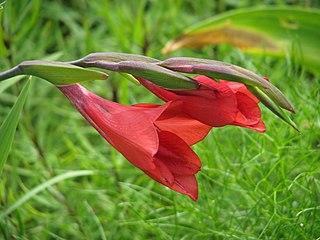
Gladiolus flanaganii is a Gladiolus species found in cliffs of the Drakensberg in Natal, South Africa.

Gladiolus orchidiflorus is a Gladiolus species found in growing in clay and sandstone soil in the grasslands of Namaqualand, South Africa.
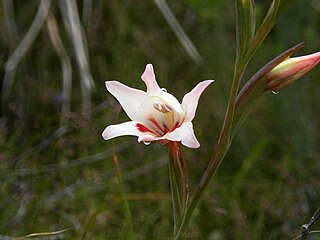
Gladiolus carneus is a plant species in the family Iridaceae.
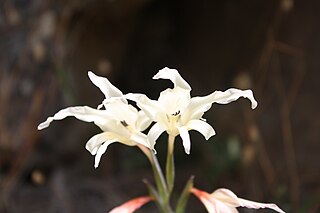
Gladiolus undulatus is a plant species in the family Iridaceae.
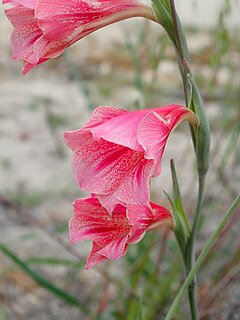
Gladiolus caryophyllaceus is a Gladiolus species native to the Cape Provinces in South Africa. It is a weed in Western Australia.

Vestiena is protected landscape in Ērgļi Municipality and Madona Municipality, approximately from Ērgļi Parish in the west to village Zelgauska in the east. The territory was established to preserve and protect the Vidzeme Highlands landscape and natural diversity. This is a Natura 2000 site.
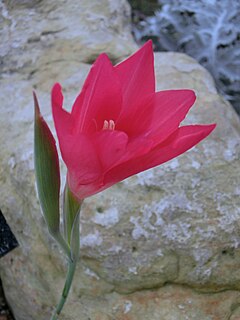
Gladiolus carmineus is a perennial plant belonging to the genus Gladiolus and is part of the fynbos. The plant is native to the Western Cape and occurs from Cape Hangklip to Cape Infanta. The plant has an occurrence area of less than 20 km2 and is threatened by development on the coast.
Sorocephalus imbricatus, the tile-leaf clusterhead, is a flower-bearing shrub that belongs to the genus Sorocephalus and forms part of the fynbos. The plant is native to the Western Cape where it is found in the Piketberg, Groot Winterhoek and Elandskloof mountains. However, plants were last observed at the latter two sites 50 years ago.
Cyperus imbricatus, also known as the shingle flatsedge, is a species of sedge that is native to sub-tropical and tropical areas of the world.
